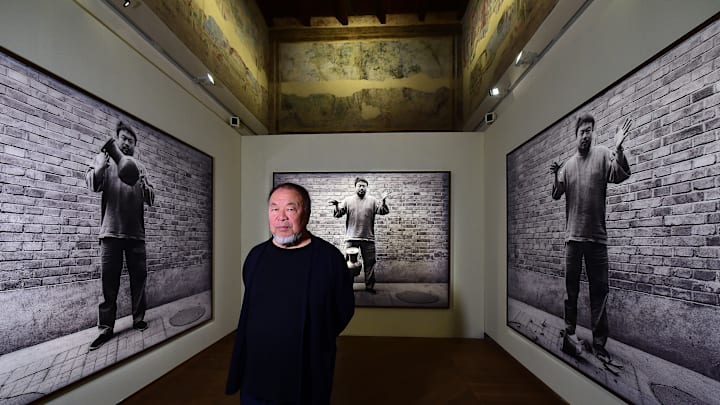In the documentary Ai Weiwei’s Turandot, the multi-disciplinary artist known for his architecture, installations and sculptures, takes his first steps into opera, an artistic medium he’s never directed. But it’s a full-circle moment for Weiwei—in 1987, he was an extra in a New York production of Giacomo Puccini’s Turandot. In 2020, he stepped into the role of opera director at the Rome Opera House, having garnered a wealth of life experiences to power his vision.

Puccini’s Turandot is set in a fantastical version of China where the Emperor refuses to allow his daughter, Turandot, to marry. Turandot herself has little interest in love and marriage. They concoct three difficult riddles for potential suitors to solve. The reward for solving the riddles is Turandot’s hand in marriage; the penalty for failure is death.
Director Maxim Derevianko uses a combination of behind-the-scenes footage, cast and crew interviews, and scenes from the completed production to demonstrate how Weiwei’s new take on a century-old opera is as much a story about the “doubts of the 20th century”, as it is about Weiwei’s own life.
Having seen Weiwei on the news often as a teenager and young adult, I was excited to experience Weiwei’s craft though Ai Weiwei’s Turandot at Hot Docs Toronto. In fact, if you lived through the 1990s and the early 2000s, Ai Weiwei will be a more than familiar name to you. A controversial artist who questioned politics and the freedom of speech, or the lack thereof, in his home country of China, Weiwei was essentially exiled from the country of his birth. But that didn’t stop him from continuing to make art, whether it was installations, films, sculptures, or sharing his political commentary on social media posts. My only real-life experience with his artistry was seeing the overwhelming ‘Fountain of Light’ sculpture in the Louvre Abu Dhabi. It was at once recognizable yet unique—which is probably the best way I would describe Ai Weiwei. Because from the outset in Ai Weiwei’s Turandot, Weiwei makes it clear that stepping out of his comfort zone is where he works best.

The first third of Ai Weiwei’s Turandot focuses on the making of Weiwei’s version of Turandot as he grapples with bringing Puccini’s famous opera to a new and modern audience. Weiwei asks himself, as he expects critics to ask of him, to interpret Puccini’s work through a different lens than what’s come before. He questions how an unfinished piece of art—Puccini died while writing Turandot in 1924—and a staple of the Italian operatic oeuvre, can continue to function in the contemporary world.
To envision this new interpretation, Weiwei draws from his own life, including the life of his revolutionary poet father, Ai Qing, who was exiled in a rural district for his inflammatory poetry. Weiwei incorporates his own tussles with political forces, including the time he was held in a secret prison for 81 days, and even following his release, was barred from speaking of his experiences there.
But as the rehearsals for Ai Weiwei’s Turandot race ahead, they are struck, as is the rest of world, by the COVID-19 pandemic. Lockdowns require the Rome Opera House to close down for the first time in its 140-year history. The opera resumes over two years later, in 2022, at which point, not only is the pandemic at play, but so is the Ukrainian War. Through moving interviews with Weiwei, choreographer Chiang Ching, an old friend of Weiwei’s, and Ukrainian conductor Oksana Lyniv, the documentary examines how the creative team, powered by Weiwei’s out-of-the-box vision, ensured all these realities influenced a powerful rendition of the opera that would be more than relevant to 21st century audiences.

As Puccini’s Turandot explored love, power, and redemption, Ai Weiwei’s work examined autocratic governments, censorship, oligarchy, war, and the pandemic. Director Derevianko cuts between rehearsals to news footage and documentary scenes to show Weiwei’s political activism and the price he paid for his vocal stance against his government. The editing by Emmanuele Bonomi is superbly executed—ramping up the tension of Weiwei’s arrests and the global horror of his disappearance. The stakes seem high despite the audience knowing that Weiwei does eventually reach safety in the future.
But the most powerful aspects of Ai Weiwei’s Turandot are the many contemplations on art itself. Weiwei says succinctly that “Everything is art. Everything is politics.” Michael Fabiano, who plays Calaf in Ai Weiwei’s Turandot, discusses how Turandot the character suppresses speech, leading to death and destruction, a construct that infuses Weiwei’s version of the opera.
At a time when fascism is on the rise on a global scale, and art is constantly besieged by technological oligarchs, Ai Weiwei’s Turandot stands as a testament to the power of human creativity, ingenuity, and resilience. A well-paced documentary that is as stylistic as it’s subject’s artistic vision, Ai Weiwei’s Turandot also highlights the importance of standing up for free speech, as dire as the consequences may be. Whether or not you have any interest in the opera or in Weiwei’s activism and artistry, you need Ai Weiwei’s Turandot to remind you to be loud, make art, and be political. Because art is politics, and art is necessary.
Ai Weiwei’s Turandot is currently screening at Hot Docs.
